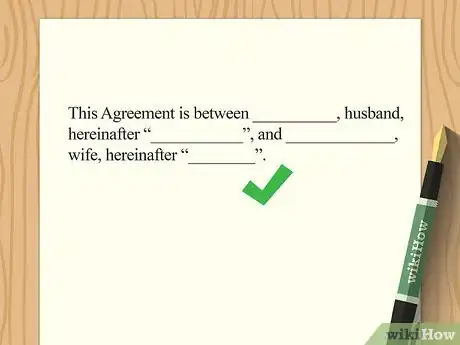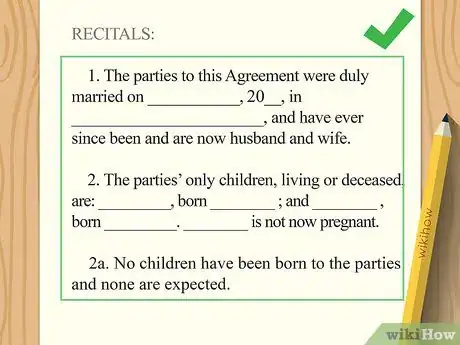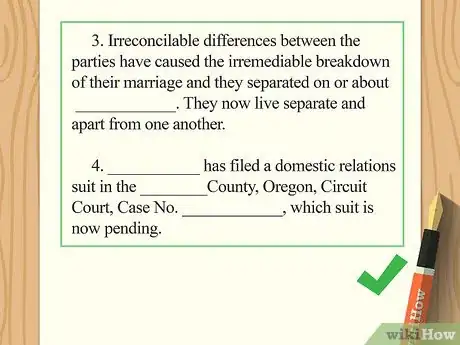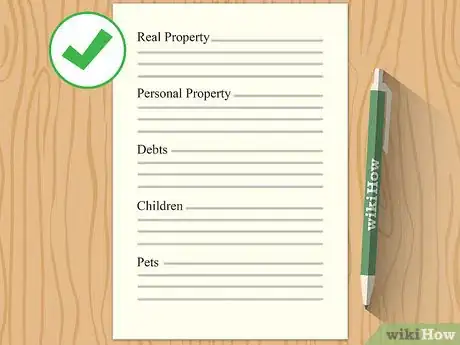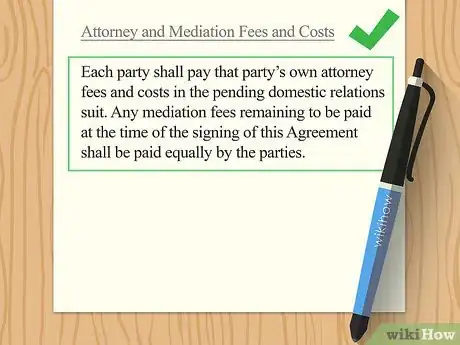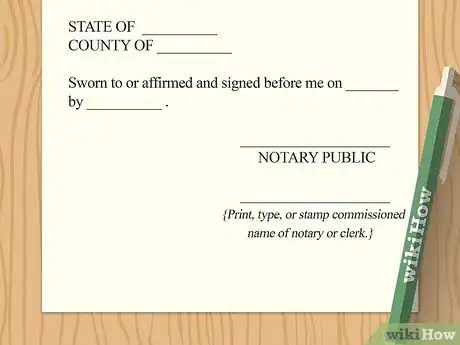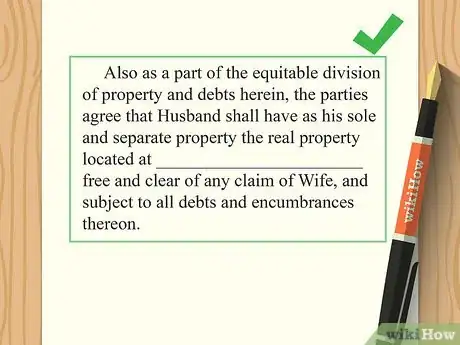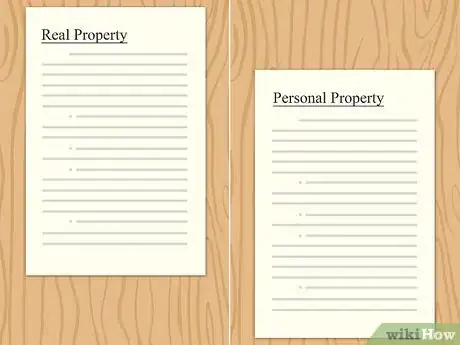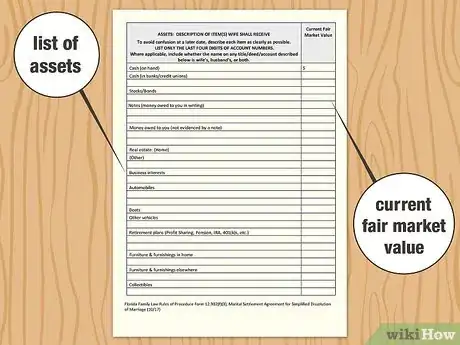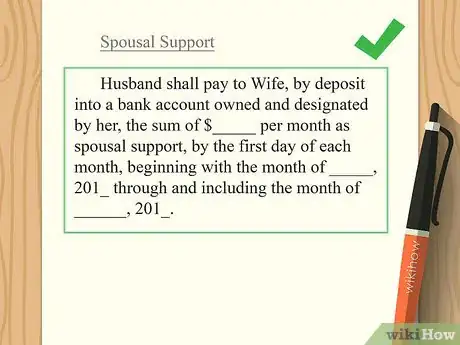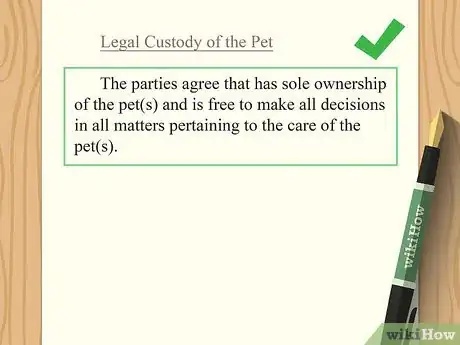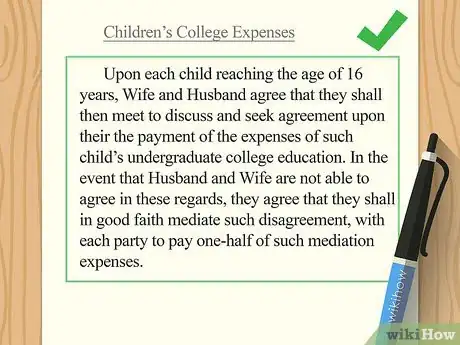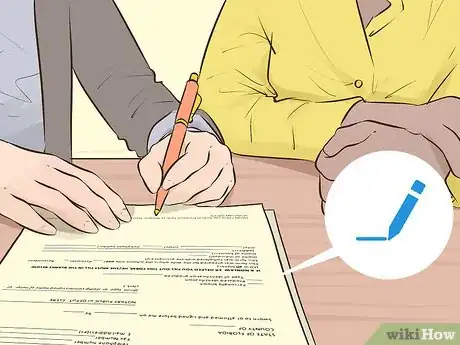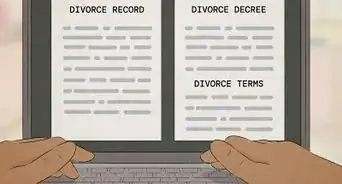This article was written by Scott Levin and by wikiHow staff writer, Jennifer Mueller, JD. Scott Levin is a Divorce Mediator & Family Lawyer, as well as the Founder of San Diego Divorce Mediation. With nearly 20 years of experience, he specializes in peacefully mediating divorces so couples split amicably. He holds a law degree from the University of Chicago School of Law and a Bachelor’s degree in Metropolitan Studies from New York University. Additionally, Scott is a licensed attorney in California, a Certified Divorce Financial Analyst, and a member of The Academy of Professional Family Mediators.
wikiHow marks an article as reader-approved once it receives enough positive feedback. In this case, 100% of readers who voted found the article helpful, earning it our reader-approved status.
This article has been viewed 287,245 times.
Divorce is stressful even in the best of circumstances. However, if both of you can agree on how you want property and debts to be split, the process can go a bit more smoothly. If you write a divorce settlement agreement, you and your partner have more control over the process. Through this agreement, you lay out how you want to divide marital property and debts, as well as address any spousal support, child support, or custody and visitation issues.[1]
Steps
Formatting Your Agreement
-
1Search for forms or templates. Most courts have forms or templates you can use to write your divorce settlement agreement. Ask the clerk of the court where you're filing for divorce. You may also be able to download forms from the court's website.[2]
- There are also commercial forms available online and in legal form books, which you can purchase at office supply stores or check out from the library. If you use a commercial form, make sure it's approved for use in your state. If the form doesn't specifically list the states where you can use it, ask a local attorney.
-
2Name the parties to the agreement. The first line of any agreement lists the names of the parties to the agreement. For a divorce settlement agreement, the parties are you and your spouse. Here, you can also specify what each of you will be called throughout the rest of the agreement.
- For example, you might write: This agreement between Sally Sunshine, spouse, hereinafter "Sunshine," and Luna Lovegood, spouse, hereinafter "Lovegood."
- If you have different last names, you can simply refer to each party by that unique last name. However, if you have the same last name, you'll have to use something else to refer to each party.
- If you are a heterosexual couple, you may prefer to be called "husband" and "wife" throughout the agreement. You can also simply use your legal names. Some couples may use designations such as "Spouse A" and "Spouse B," but this can often get confusing. Stick to something by which each of you will be readily identifiable without having to go back to the top of the agreement and figure out who's who.
Advertisement -
3Provide information about the marriage. The next lines of your agreement set forth the date and location of your marriage and whether you have any children. If you don't have any children, include a statement to that effect.
- For the first part, you might write something like "The parties to this Agreement were legally married on October 31, 2016, in San Francisco, California, and have been married ever since."
- If you have children, you would then write "The parties' only children, living or deceased, are" followed by the names of your children and their dates of birth. If either spouse is capable of having children, include a statement about whether they are currently pregnant.
- If you don't have children, you can simply include a statement such as "No children have been born to the parties and none are expected."
Tip: Get a certified copy of your marriage certificate, as well as certified copies of the birth certificates of any children you have. You'll need them for your divorce proceeding.
-
4Include a statement about your separation and pending divorce. After the information about the marriage, provide the date you and your spouse separated. Then list who filed the divorce proceeding, the name and location of the court where it was filed, and the case number.
- For example, you might write: "Irreconcilable differences between the parties have caused the irremediable breakdown of their marriage and they separated on or about December 26, 2018. They now live separate and apart from one another."
- Add another line with information about your divorce proceeding. If no petition for divorce has been filed yet, include a statement such as "The parties, or one of them, anticipate soon filing a domestic relations suit." Then list the name of the court where the lawsuit will be filed.
-
5Outline the sections of the agreement. If you're not using a prepared form, write headings in your document for the various subjects you and your partner have come to an agreement about. These headings will help you organize your document.
- For example, you might have headings for "Real Property," "Personal Property," "Debts," "Children," and "Pets."
- When you fill in the agreement, number each statement under the sections. That way, specific things will be easy to reference.
-
6Describe any agreement made regarding legal fees and court costs. Towards the end of your agreement, include a statement specifying whether either or both of you have hired attorneys, and who will be responsible for legal fees or court costs.
- If neither of you have hired an attorney, this clause typically entails a disclaimer that both of you understand that you have the right to the assistance of legal counsel and have voluntarily chosen not to avail yourselves of that right.
- If you've agreed to split the court costs and filing fees associated with the divorce, you can include this in the settlement agreement. You might also include any agreement you've made regarding who will file the suit and when it will be filed.
-
7Include space for signatures and a notary seal. Leave 2 or 3 lines blank for each signature. Type a blank line, then type your full legal name and your spouse's full legal name. Use your married names, even if you've agreed to change your names after the divorce, because the divorce hasn't been finalized yet.[3]
- Underneath the space for your signatures, add a notary block. You can copy this from any legal document. Make sure the notary block remains on the same page as the signatures as you add provisions to your agreement.
Dividing Property and Debts
-
1Use a simple disclosure if property is minimal, or has already been split up. If you and your spouse have been separated for quite some time, chances are you've already decided who gets what. If that's your situation, there's no need to go into specific detail in the section of your agreement that divides property and debts.[4]
- For example, you might write "The parties agree that their marital property and debts are minimal, and have already been divided to their mutual satisfaction."
-
2Acknowledge separate property owned prior to the marriage. In a divorce, your marital property is divided between the two of you. However, your separate property is not divided and remains the sole property of the spouse who originally owned it. If there is any separate property of significant value, list it for each spouse.[5]
- For example, suppose you had a mint-condition 1963 Porsche 911 that you bought several years before you and your spouse got married. That car is your separate property and should be acknowledged as such in your settlement agreement.
- If joint assets are used to maintain or improve separate property, the judge may decide it's actually marital property and needs to be split fairly. However, if you both acknowledge it as separate property you can avoid this.
-
3Discuss real property separately from personal property. If you and your spouse own a home, land, or other real property, decide what's going to happen to it. If one of you is going to stay in the house, you may want to get the other spouse's name off the deed.[6]
- For example, suppose you and your spouse bought a home in your first year of marriage. You have a mortgage for $150,000 and $80,000 equity in the home. If you and your spouse agree that your spouse will stay in the home, your agreement will need to cover getting your name off the deed and mortgage.
- Deciding what to do with a home or other real estate can be one of the most difficult and expensive parts of getting a divorce. However, keep in mind that if you go to court without an agreement, the judge may order the property sold. If either you or your spouse has any interest in keeping the property, it's worth the time and effort to come to an agreement about it.
Tip: Neither your settlement agreement nor your divorce decree actually transfers title to real property (or personal property, such as a car, that has a title). After your divorce is finalized, you and your spouse will have to transfer that property according to local rules.
-
4Provide a list of assets that each spouse will receive. Your marital assets include physical property such as cars, furniture, and household items, as well as banking and investment accounts, life insurance policies, and retirement funds. Above the list, write a statement identifying the spouse who will receive the property and stating that they will have full ownership and possession of that property. Then list the property along with its approximate value. Do the same for the other spouse.[7]
- Valuable items such as cars, boats, jewelry, and furniture should be listed individually. For other items, you can simply include a category and an estimated value for everything in that category. For example, you might list "Clothing" for each of you and assign a value of $2,000.
- For banking and investment accounts, include an account number and identify the financial institution where the account is held.
Tip: Describe property and assets as specifically as possible to avoid confusion later. You can even take pictures and attach them or include them as exhibits to your agreement.
-
5Include a list of debts that each partner has agreed to pay. Follow the same format as you did for assets. Write a statement identifying the spouse who has agreed to pay the debts. Then list a description of the debt and the amount owed. Do the same thing for the other spouse.[8]
- If you have secured debts, the debt typically follows the property it is attached to. So for example, if you are making payments for a car and you and your spouse agree that you will keep that car, you would typically be responsible for the payments as well.
Tip: Your creditors are not bound by your settlement agreement and can come after either or both of you for payment of joint debts. Unpaid debts will still go on your credit report and affect your credit score, even after the divorce is finalized.
Addressing Support and Custody Issues
-
1Decide if either of you will receive spousal support from the other. Spousal support is most often an issue when one divorcing spouse makes a lot more money than the other. It can also be an issue if one spouse has taken time off work and was dependent on the other spouse as a result. If you do not include spousal support in your divorce settlement agreement, the judge will decide this issue for you when you get divorced.[9]
- Spousal support is most common when one spouse quits work to stay home with the couple's small children. Spousal support is also common if one spouse makes a lot more money than the other, and as a result, the other spouse has become accustomed to a particular lifestyle.
- In your agreement, you can specify not only the amount of spousal support but the length of time those payments will be made. You can also decide whether you'll simply pay the money between yourselves or have the paying spouse's wages garnished.
- If you decide that neither of you will receive any spousal support, include a statement that says something like "Each of us gives up any right to spousal support that we may have."
-
2Describe any agreement regarding pets you own. Which divorcing spouse gets to keep any marital pets is an issue that can be just as fraught as child custody for many couples. However, as part of your settlement agreement, you can establish rules regarding your pets that are just as detailed as parenting plans for children. As long as the two of you agree, the arrangement can be enforced in court.[10]
- For example, you might decide that your spouse will have full ownership of your dogs, but that you can take them every other weekend. You can even agree that the non-custodial spouse will pay a certain amount each month to help with the cost of food, supplies, and veterinary bills.
- You may also want to specify your pet's veterinarian or make agreements regarding how often your pet will be taken to the vet for regular check-ups.
-
3Check your state's guidelines about child support and parenting plans. All states have specific guidelines for calculating how much child support should be paid, and by which spouse. You typically cannot deviate from these requirements unless strict conditions are met.[11]
- Most states have specific forms you'll need to fill out that show how you calculated child support and describe the specifics of your parenting plan. Talk to the clerk of the court where you filed (or plan to file) for divorce. These forms are also often available for download from the court's website.
- While you can outline the specifics of your child support agreement and parenting plan in the body of your settlement agreement, it's generally easier to fill out the required forms and incorporate them by reference. For example, under the section in your agreement labeled "Child Support and Custody," you could write "The state child support and parenting plan worksheets are attached and incorporated into this agreement by reference."
- If your local child support agency is involved in your case, they will likely have to sign off on your parenting plan and child support agreement.
Tip: The judge will still evaluate your child custody and support arrangements to determine whether they are in the best interests of your child (or children). The judge may also ask older children about their preferences.
-
4Add any other agreements related to inheritance or college expenses. Even in the midst of a divorce, it's natural for parents to want to provide for their children's future. If you and your spouse have made any agreements regarding future expenses for your children, you can include those in your settlement agreement.
- For example, if your spouse has opened a savings account that they contribute to for your child's college expenses, you would include the account number, balance, and financial institution of that account, along with a statement regarding the purpose of the funds.
- If you or your spouse agree to contribute funds for your child's college or other expenses in the future, you may be able to deduct a portion of those amounts from any child support payments. Talk to a family law attorney or family court facilitator about how this works.
Finalizing Your Agreement
-
1Proofread your agreement carefully. Go over the written agreement several times with your spouse. Double-check any account numbers or figures against your financial records to make sure they're accurate.[12]
- In many states, you and your spouse are required to complete financial disclosure forms that outline your separate and marital assets. The accounts and balances on your settlement agreement must match the accounts and balances on your financial disclosure forms.
-
2Have an attorney look over your agreement. Even if you and your spouse agree on everything contained in your settlement, it's still a good idea to get an attorney who specializes in family law to review the document. They can make sure everything is there that is necessary for the document to be legally binding in your state.[13]
- An attorney can also make sure that the format of your agreement will be acceptable for your local court.
- If you can't afford an attorney, your local family court may have a family court facilitator or self-help clinic that can look over your papers at no charge. Having someone else look over them could save you confusion or potential delays if something isn't written correctly or if you've left out a necessary provision.
-
3Sign your agreement in the presence of a notary. Most states require divorce settlement agreements to be notarized. You and your spouse need to take the unsigned document together so you can both sign. The notary will verify your identification, witness the signatures, and then affix their seal.[14]
- Notaries are available at the courthouse and at most banks. Plan on going together so the notary can witness both of your signatures at the same time.
Tip: A notary won't look over your document for you, and they can't provide legal advice. They simply confirm the identity of the parties and witness signatures.
-
4File your agreement with the court. If you've already filed a petition for divorce, you typically can file a settlement agreement without having to pay any additional filing fees. If you haven't yet filed for divorce, include your settlement agreement as an attachment to your petition.[15]
- Typically you will need to make at least 2 copies of your agreement to file along with the original. The copies are for you and your spouse – the clerk will stamp them filed and return them to you. The court will keep the original.
- You may want to call the clerk's office ahead of time and find out what the specific requirements are. Each state has its own filing requirements and individual courts may have their own local rules.
Expert Q&A
-
QuestionIs mediation a good idea in divorce?
 Scott LevinScott Levin is a Divorce Mediator & Family Lawyer, as well as the Founder of San Diego Divorce Mediation. With nearly 20 years of experience, he specializes in peacefully mediating divorces so couples split amicably. He holds a law degree from the University of Chicago School of Law and a Bachelor’s degree in Metropolitan Studies from New York University. Additionally, Scott is a licensed attorney in California, a Certified Divorce Financial Analyst, and a member of The Academy of Professional Family Mediators.
Scott LevinScott Levin is a Divorce Mediator & Family Lawyer, as well as the Founder of San Diego Divorce Mediation. With nearly 20 years of experience, he specializes in peacefully mediating divorces so couples split amicably. He holds a law degree from the University of Chicago School of Law and a Bachelor’s degree in Metropolitan Studies from New York University. Additionally, Scott is a licensed attorney in California, a Certified Divorce Financial Analyst, and a member of The Academy of Professional Family Mediators.
Divorce Mediator & Family Lawyer Sure! The mediator will bring up all the topics that are relevant to the couple and their family, helping them resolve any disputes they might have about how to handle a specific issue. Then, he drafts a marital settlement agreement for them, which is the legal document that contains all the agreements they made together. Then, that gets submitted to the court.
Sure! The mediator will bring up all the topics that are relevant to the couple and their family, helping them resolve any disputes they might have about how to handle a specific issue. Then, he drafts a marital settlement agreement for them, which is the legal document that contains all the agreements they made together. Then, that gets submitted to the court.
Warnings
- This article describes the process of writing a divorce settlement agreement in the US. If you live in another country, the rules governing divorce may be different. Consult a local attorney who specializes in family law.⧼thumbs_response⧽
- Check the specific rules in your state before writing a divorce settlement agreement according to these steps. You may want to have a local lawyer who specializes in family law look over your agreement to make sure it follows the appropriate rules.⧼thumbs_response⧽
Expert Interview

Thanks for reading our article! If you'd like to learn more about divorce processes, check out our in-depth interview with Scott Levin.
References
- ↑ https://www.flcourts.org/content/download/403048/3456622/902f3.pdf
- ↑ https://www.flcourts.org/content/download/403048/3456622/902f3.pdf
- ↑ https://www.flcourts.org/content/download/403048/3456622/902f3.pdf
- ↑ https://www.flcourts.org/content/download/403048/3456622/902f3.pdf
- ↑ https://michiganlegalhelp.org/self-help-tools/family/divorce-basics-dividing-your-property-and-debt#
- ↑ https://michiganlegalhelp.org/self-help-tools/family/divorce-basics-dividing-your-property-and-debt#
- ↑ https://www.flcourts.org/content/download/403048/3456622/902f3.pdf
- ↑ https://michiganlegalhelp.org/self-help-tools/family/divorce-basics-dividing-your-property-and-debt#
- ↑ https://www.courts.ca.gov/1038.htm#acc12344
- ↑ https://www.isba.org/sections/animallaw/newsletter/2014/02/petprovisionsmaritalsettlementagree
- ↑ https://www.courts.ca.gov/selfhelp-support.htm#acc11400
- ↑ https://www.courts.ca.gov/8410.htm#def_writeup
- ↑ https://www.courts.ca.gov/8410.htm#def_writeup
- ↑ https://www.courts.ca.gov/8410.htm#def_writeup
- ↑ https://www.courts.ca.gov/8410.htm#def_writeup

